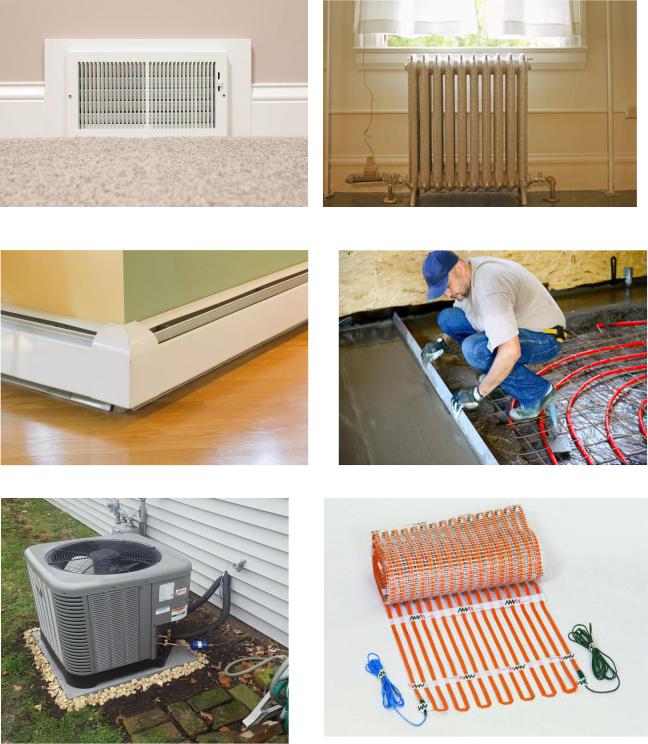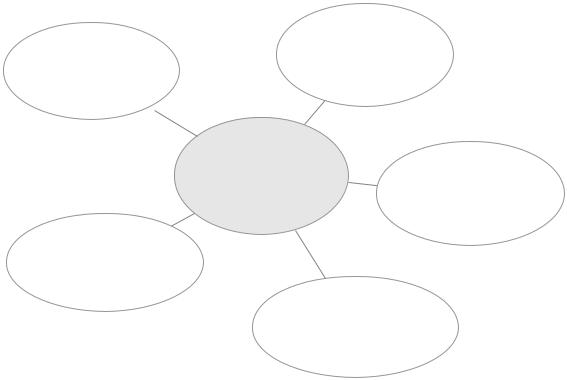
9326
.pdf
2.4. HEATING SYSTEMS
Lead in
1. How can you define a heating system? What types of heating systems do you know? What types of heating systems are presented in the pictures? What are their specific features?
a)________________________ |
b)________________________ |
c)__________________________ d)_________________________
e)__________________________ f)_________________________
40
2. Study the following vocabulary. What types of heating systems does it characterize? How do you understand the abbreviation HVAC?
ambient temperature furnace
ducts blower fan be fueled maintenance
radiant heating system plastic water tubing piping
hydronic heating
boiler and radiator system reheating
remain unobstructed heat pump wall-mounted units evaporator coils baseboard heaters convection
Reading task
1. Read the following text and check your answers. While reading mark the information:
I knew this fact ( V )
I didn’t know this ( + )
I was wrong about this ( - )
I need some more information about this ( ? )
TYPES OF HEATING SYSTEMS
There are several types of systems used to provide heat in a home, and within each broad type there are many variations. Some heating systems share components with the home's cooling equipment, and some systems provide both heating and cooling. The term HVAC—heating, ventilation, and air-conditioning—is used to describe the overall climate control system in a home.
No matter what HVAC system is used, the purpose of all heating appliances is to tap the thermal energy from a fuel source and transfer it to living spaces to maintain a comfortable ambient temperature. Heating systems can use a variety of fuel sources, including natural gas, propane, fuel oil, biofuel (such as wood), and electricity. Some homes have more than one heating system, such as when an
41
addition or finished basement is heated by a different system than the rest of the house.
Forced Air Heating/Cooling Systems
By far the most common HVAC system in modern North American homes is the forced-air system that uses a furnace with a blower fan that delivers warmed air to the various rooms of the home through a network of ducts. Forced air systems are very quick at adjusting the temperature of a room, and because air conditioning systems can share the same blower and ductwork, this is an efficient overall HVAC System.
Fuel sources: The furnaces that power forced-air systems can be fueled by natural gas, liquid propane (LP), fuel oil, or electricity.
Distribution: Air that is warmed in by the furnace's burner or heating element air is distributed through a network of ducts to heating registers in individual rooms. Another system of ducts returns air back to the furnace through cold-air returns.
Advantages:
Forced air systems can be filtered to remove dust and allergens. However, they also can increase the amount of allergens that are airborne.
Humidifier (or dehumidifier) equipment can be integrated into the forced air system.
Forced air furnaces are relatively inexpensive.
These furnaces can achieve the highest AFUE (Annual Fuel Utilization Efficiency) ratings of any heating system (but that does not necessarily mean this is the most efficient way to heat a home).
Forced air systems can combine cooling with heating capability. Disadvantages:
Requires ductwork and takes up space in walls. Furnace fans can be noisy.
Moving air can distribute allergens.
Moving air can become dry unless it is humidified.
Because forced air systems heat the air and not the objects in a room, it is not considered the most comfortable form of heating.
Gravity Air Furnace Systems
A precursor to forced air systems, gravity air furnaces also distribute air through a system of metal ducts, but rather than forcing the air via a blower, gravity air systems operate by the simple physics of warm air rising and cool air sinking. A gravity air furnace in a basement heats air, which then rises into the various rooms through ducts. Cool air returns to the furnace via a system of cold-air return ducts. The so-called "octopus" furnaces found in many older homes are gravity air furnaces.
42
Gravity air systems are no longer installed, but in many older homes they continue to perform effectively.
Fuel source: Forced air furnaces can be fueled by natural gas, liquid propane (LP), fuel oil, or electricity.
Distribution: Conditioned air is circulated through a network of metal ducts. Advantages:
Gravity systems have no moving parts and can last for many decades. The system equipment is very dependable and requires little maintenance. Disadvantages:
Air cannot be filtered effectively.
Energy efficiency is lower than with newer furnaces.
Temperature adjustments are slow because the systems operate by simple convection currents.
In-Floor Radiant Heating Systems
Modern in-floor heating is a type of radiant heating system. Radiant heating is different from forced air heat in that it heats objects and materials, such as furniture and flooring, rather than just the air. Most whole-home radiant systems distribute heat via hot water heated in a boiler or hot water heater.
In-floor heating involves plastic water tubing installed inside concrete slab floors or attached to the top or bottom of wood floors. It is quiet and generally energy efficient. It tends to heat more slowly and takes longer to adjust than forced air heat, but its heat is more consistent.
There are also in-floor systems that use electrical wiring installed under flooring materials, typically ceramic or stone tile. These are less energy efficient than hot water systems and are typically used only in small rooms such as bathrooms.
Fuel sources: Hot water tubing systems are usually heated by a central boiler, which can be fueled by natural gas, liquid propane (LP), or electricity. Hot water also can be provided by solar hot water systems, which are commonly used to supplement fuel-based systems.
Distribution: In-floor systems are usually distributed by hot water flowing through plastic tubing.
Advantages:
Radiant systems provide comfortable, even heat.
When heated by boilers, radiant systems can be very energy efficient. Disadvantages:
Radiant systems are relatively slow to heat up and adjust to temperature changes.
43
Installation of in-floor systems can be expensive.
It is difficult access to hidden piping if maintenance problems emerge. Boiler-based systems cannot be combined with air conditioning.
Traditional Boiler and Radiator Systems
Older homes and apartment buildings in North America often are heated with traditional boiler and radiator systems. These include a central boiler that circulates steam or hot water through pipes to radiator units positioned strategically around the house. The classic radiator – a cast-iron upright unit usually positioned near windows
– is often called a steam radiator, although this term is sometimes inaccurate.
In reality, there are two types of systems used with these older radiators. True steam boilers actually do circulate gaseous steam through pipes to individual radiators, which then condenses back to water and flows back to the boiler for reheating. Modern radiator systems circulate hot water to radiators via electric pumps. The hot water releases its heat at the radiator, and the cooled water returns to the boiler for more heating. Hot water radiator systems are very common in Europe.
Fuel sources: Boiler/radiator systems can be fueled by natural gas, liquid propane, fuel oil, or electricity. Original boilers may even have been fueled by coal.
Distribution: Heat is produced by steam or hot water circulating through metal pipes to radiators shaped to facilitate the transfer of thermal energy.
Advantages:
Radiant heat is quite comfortable and does not dry out the air as forced-air heat
does.
Radiators can be updated to low-profile baseboard or wall-panel radiators.
When old boilers are replaced, modern boilers can offer very good energy efficiency.
Disadvantages:
Radiators can be unsightly.
Radiator locations may limit furniture placement and window coverings. Boiler-based systems cannot be combined with air conditioning.
Hot Water Baseboard Radiator
Another more modern form of radiant heat is a hot water baseboard system, also known as a hydronic system. These systems also use a centralized boiler to heat water that circulates through a system of water pipes to low-profile baseboard heating units that radiate the heat from the water out into the room via thin metal fins surrounding the water pipe. This is essentially just an updated, evolved version of the old upright radiator systems.
Fuel Sources: Boilers for hydronic systems can be fueled by natural gas, liquid propane (LP), fuel oil, or electricity. They can also be aided by solar heating systems.
44
Distribution:
Hot water heated by a boiler and piped to "fin-tube" baseboard units mounted along walls. The fins increase the surface area of heat dissipation for efficiency.
Heat is distributed by natural convection: Heated air rises from the baseboard unit, while cold air falls toward the unit for heating.
Advantages:
Hydronic systems can offer excellent energy efficiency. Hydronic systems are quiet because there are no fans or blowers. Temperature can be precisely controlled.
Radiator systems are very durable and need little maintenance. Disadvantages:
Baseboard radiation/convection units must remain unobstructed and can provide challenges in furniture placement and drape design.
Radiators are slow to heat up.
Hot water systems cannot be combined with air conditioning systems.
If the heat goes out for an extended period, heating pipes may be at risk of freezing.
Heat Pump Heating Systems
The newest home heating (and cooling) technology is the heat pump. Using a system that is similar to an air conditioner, heat pumps extract heat from the air and deliver it to the home via an indoor air handler. Standard home systems are air-source heat pumps that draw heat from the outdoor air. There are also ground-source, or geothermal, heat pumps that pull heat from deep in the ground as well as watersource heat pumps that rely on a pond or lake for heat.
A popular type of air-source heat pump is the mini-split, or ductless, system. This has a relatively small outdoor compressor unit and one or more indoor air handlers that are easy to add to room additions or remote areas of a home. Many heat pump systems are reversible and can be switched to air conditioning mode in the summer. Heat pumps can be energy efficient, but they are suitable only for relatively mild climates; they are less effective in very hot and very cold weather.
Fuel sources: Heat pumps are usually powered by electricity, although natural gas models are also available.
Distribution: Heat (and cooling) are provided by wall-mounted units that blow air across evaporator coils linked to an outdoor pump that extracts or absorbs heat from the outdoors.
Advantages:
Systems offer both heating and cooling.
45
Heat pumps can be very energy efficient.
Individual wall units allow for precise control of each room. Fans are quieter than central forced-air systems.
No ductwork is required. Disadvantages:
Heat pumps are best suited for relatively mild climates.
Distribution of heated or cooled air can be limited because it comes from a single unit (in each room or area).
Electric Resistance Heating Systems
Electric baseboard heaters and other types of electric heaters are not commonly used for primary home heating systems, mostly due to the high cost of electricity. However, they remain a popular option for supplemental heating in finished basements, home offices, and seasonal rooms (such as three-season porches and sunrooms). Electric heaters are easy and inexpensive to install, and they require no ductwork, pumps, air handlers, or other distribution equipment. The units are inexpensive and have no moving parts and require virtually no maintenance.
In addition to conventional baseboard heaters, there are electric radiant heaters that heat with radiation. These typically are installed near the ceiling and are directed toward the room occupants, providing more focused heat than you get with baseboard units. Radiant heaters also are more energy efficient than baseboard units.
Distribution: Baseboard heaters use natural convection to circulate heat throughout the room. Wall-mounted heaters and many specialty heaters (like toekick heaters) usually have internal fans that blow out heated air.
Advantages:
Heater units are versatile and can be installed almost anywhere. Systems need only an electrical circuit for power.
Units without fans work silently.
Radiant electric heaters heat room objects, similar to in-floor radiant heat. No ductwork or expensive installation is needed.
Disadvantages:
Electric heaters are very expensive to operate.
They use a lot of electricity and therefore contribute disproportionately to overuse of the electric utility grid and related problems.
Most electricity is generated by coal-fired power plants, so electric heaters, while clean to operate, contribute significantly to air pollution and atmospheric carbon.
46

2.Put information into the table and discuss it with your partner.
3.Compare information from the table with your partner. What other heating systems types do you know about?
4.Use the information from the texts and complete the following table. Add more information about the types of heating systems you know about. Continue the table and think about their advantages and disadvantages.
|
Type |
|
Advantages |
|
|
|
Disadvantages |
||
|
|
|
|
- |
|
|
|
- |
|
|
Forced Air |
|
|
- |
|
|
|
- |
|
|
Heating/Cooling |
|
|
- |
|
|
|
- |
|
|
Systems |
|
|
|
|
|
|
|
|
|
|
|
|
|
|
|
|
|
|
|
|
|
- |
|
|
- |
|
||
|
Gravity Air Furnace |
- |
|
|
- |
|
|||
|
Systems |
- |
|
|
- |
|
|||
|
|
|
|
|
|
|
|
||
|
|
|
|
- |
|
|
|
- |
|
|
In-Floor Radiant |
|
|
- |
|
|
|
- |
|
|
Heating Systems |
|
|
- |
|
|
|
- |
|
|
|
|
|
|
|
|
|
|
|
|
|
|
- |
|
|
- |
|
||
|
Traditional Boiler |
- |
|
|
- |
|
|||
|
and Radiator Systems |
- |
|
|
- |
|
|||
|
|
|
|
|
|
|
|
||
|
|
|
|
- |
|
|
|
- |
|
|
Hot Water Baseboard |
|
|
- |
|
|
|
- |
|
|
Radiator |
|
|
- |
|
|
|
- |
|
|
|
|
|
|
|
|
|
|
|
|
|
|
- |
|
|
- |
|
||
|
Heat Pump Heating |
- |
|
|
- |
|
|||
|
|
|
|
|
47 |
|
|
|
|

Systems |
- |
- |
|
|
|
|
- |
- |
Electric Resistance |
- |
- |
Heating Systems |
- |
- |
|
|
|
|
|
|
|
|
|
5. Group work: Make a cluster and present the most widely used HVAC systems in your country.
HVAC
IN RUSSIA
48

2.5. MY MASTER DEGREE WORK
Lead in
-Have you ever given presentations in English?
-Was it a successful presentation? Why? Why not?
-What examples of good presentations can you give
-What is important when you present
-something? Give your tips
Compare your tips with those that presented in the diagram.
Presentation tips
49
